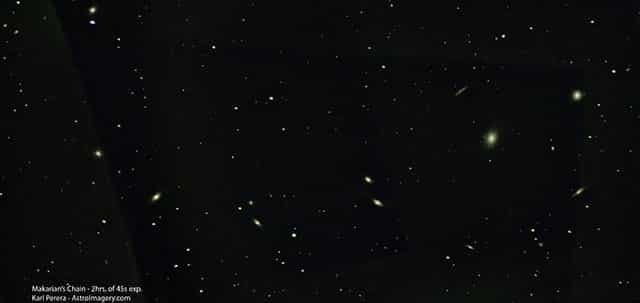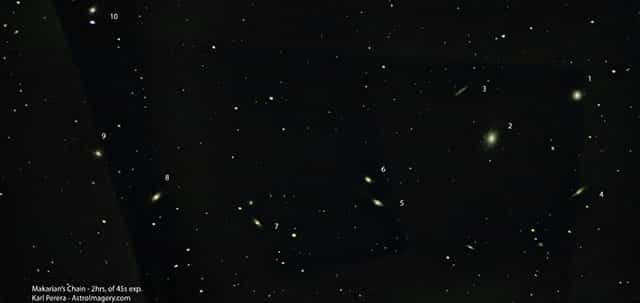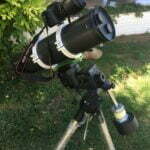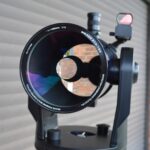Table of Contents
About 6 months after starting my adventure into astrophotography, I came across an interesting winter target, Markarian’s chain, and thought it would be very cool to photograph it from my backyard. So, armed with my beginner’s equipment, a Celestron Newtonian 130 SLT reflector telescope with Goto mount, and a Canon 600D DSLR, I set about taking images.
What is Markarian’s Chain?
Markarian’s Chain is a string of galaxies in the Virgo cluster, that is located in the constellation of Ursa Major. It was named after Armenian astronomer Viktor Ambartsumian in 1947. You can take photographs of this object quite easily with a small to medium-sized telescope or zoom lens on a DSLR. It is one of the most interesting galaxy chains you can see with a telescope.
Shop at Amazon – SvBony Telescope. Approx. $480*

If you buy this, I’ll get a small commission. *Price can vary.
M86 and M87 were the first of these galaxies to be discovered by Charles Messier in 1781. Other galaxies were discovered later in the next hundred years and Markarian discovered that they all moved together in 1960, whereupon this object was named after him.
The chain consists of several galaxies including M109, M86, and NGC 3109. The first two galaxies are elliptical galaxies while the third one is a spiral galaxy. Nice video here with a tour of the entire area of Makarian’s Chain.
The chain is not a physical object, but rather a conceptual one. It is the chain of galaxies that are gravitationally bound to each other. But how many are there? I took a series of photographs and then stacked them together before processing them in Photoshop and this is what I got:

So how many galaxies can you see in the image above? Take a few moments and look carefully. Clue: there are more than three in this shot.
The picture above was stacked in Sequator and processed for color calibration and background extraction in Siril. It was taken in a Bortle 5 rural sky. Learn how to image galaxies here.
Now the answer, how many galaxies could you spot, I’ve numbered them in the image below:

So, I found at least ten different galaxies in this target and maybe there are even more. To make things clearer I bumped up the yellow color in the galaxies above. At only two hours of exposure, there is not a great deal of detail if you zoom in and there is still quite a bit of noise that would be removed by stacking even more photos.
According to astronomy.com, there are 11 galaxies which are as follows:
- M84 elliptical galaxy
- M86 elliptical galaxy
- M87 elliptical galaxy
- M58 spiral galaxy
- M59 elliptical galaxy
- M60 elliptical galaxy
- NGC4458 elliptical galaxy
- NGC4435 lenticular galaxy
- NGC4473 elliptical galaxy
- NGC4477
- NGC4461
- NGC4438
There are quite a few other images of Markarian’s Chain galaxies taken by readers of the BBC Sky at Night website here. I particularly like the detail in some of these, perhaps I can have another go at this myself in the future now that I have better equipment and can take longer exposures.
The galaxies which feature in this group are amongst approximately 2000 that exist in the Virgo Cluster of galaxies. These galaxies all interact with each other and also with our own galaxy, the Milky Way.
I plan to return again to this target as both my imaging and processing skills are better and so is my equipment. Now I have an equatorial mount, the ioptron CEM26 which enables me to do longer exposures of several minutes. The 45-second exposures of the above images were right at the upper limit for my ALT AZ mount.
I took this image in April 2021, as Spring is the best season to photograph these galaxies.
On the Galactic Hunter website, published by a couple who live in the USA and produce very informative and entertaining astrophotography videos, is a very nice image of this group of galaxies. Their image consists of four hours of exposure. That’s what I’ll aim to do next time. I’ll also increase each exposure to about two minutes which should give me a better-quality picture.
If you need some help choosing the length of your exposures, try my exposure calculator.
How far away is Markarian’s chain?
According to Astronomy.com, it is between 50 and 55 million light-years away! So, when you look at my images above you are looking back in time 50 million years!
Because they are so far from us, it is pretty much impossible with small telescopes, like I have, to see anything more than small fuzzy balls. But, think about the incredible sight of ten galaxies. Each of these could be home to billions of stars, planets, and even other beings. Who knows! What telescope do you need to view galaxies?
Conclusion: Is it worth Imaging Makarian’s Chain?
My answer to this is simply YES! There are no more amazing thought-provoking astrophotography images than one frame that contains so many galaxies. Your telescope becomes a time machine looking back over 50 million years to the potential home of other life in our incredible universe. How could you not wish to photograph this amazing deep sky object. ? Good luck!






